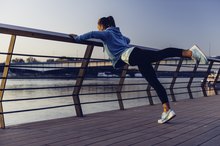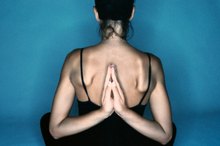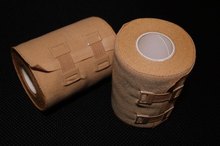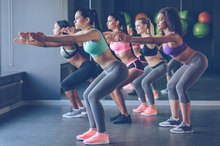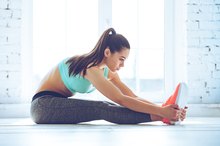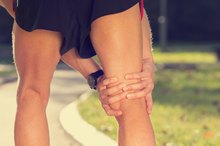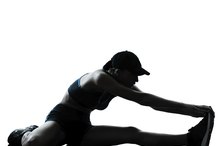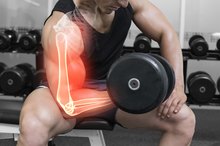Human Leg Muscles & Tendons
You hear them referred to as your "gams," "poles" or "limbs." But, whatever you call them, your legs are composed of bones, muscles, tendons and ligaments. This soft tissue works together -- with your bones -- to help your legs stretch, bend, flex and perform other general movements.
Your leg has several primary groups of muscle as well as several tendons. Tendons connect your muscles to your bones and act as cables, allowing your bones to move your muscles.
Quadricep Muscles
Your quadricep muscles, also known as quads, consist of four muscles that compose the front of your leg; hence the name quads --meaning four. This is the group of muscles that you often see body builders flexing, which protrude just above the knee and take up most of the upper leg. They consist of the rectus femoris, vastus intermedius, vastus lateralis and the vastus medialis. These four muscles overlap each other and work together to straighten the knee and help you perform exercises such as squats, lunges and leg extensions.
Read More: Build a Better Body: 4 Weeks to Stronger Legs
- Your quadricep muscles, also known as quads, consist of four muscles that compose the front of your leg; hence the name quads --meaning four.
- This is the group of muscles that you often see body builders flexing, which protrude just above the knee and take up most of the upper leg.
Hamstrings
Muscles Used in Hip Extension
Learn More
Your hamstrings are the muscles that compose the back of your legs and consist of a group of three muscles. The three muscles include the biceps femoris, semimembranosus and semitendinosus. Unlike your quads, these muscles help you bend your knee and extend, or straighten, your hip and perform exercises such as raising your knees to your chest or making your heels touch your buttocks.
Quad and Patellar Tendons
Your quad and patellar tendons are located within a close proximity because each of them help control your quadricep and knee muscles. Your knee cap is also called the patellar bone, and the patellar tendon connects part of your quad muscles to your knee cap so when your brain tells your muscle to straighten your leg, it can do so by the force of your knee cap moving.
Hamstring Tendon
List of Muscles Attached to Major Bones of Body
Learn More
Your hamstring muscles connect to the back of your knee via the hamstring tendon. This tendon helps your leg bend when you raise your knee. Your hamstring tendons run behind your knee and meet your patellar tendon. All of these tendons protect and house the four ligaments inside of your knee, including your medial collateral ligament, lateral collateral ligament, anterior cruciate ligament and posterior cruciate ligament. These ligaments are often referred to as your MCL, LCL, ACL and PCL; all of them connect your femur to your tibia but in different positions.
- Your hamstring muscles connect to the back of your knee via the hamstring tendon.
Calves and Achilles Tendon
Two muscles make up the calves of the lower leg. The gastrocnemius is the bulging muscle that's most visible. It allows your foot to flex as you walk or run. It's also instrumental in bending the knee.
The soleus muscle lies underneath the gastrocnemius. It's flat and thick, rising from the bones of the tibia and fibula, and works to extends to the heel. It also assists in plantar flexion of the foot.
The soleus attaches at the Achilles tendon, a thick band of connective tissue at the back of your ankle and heel. It connects your calf to your heel and works as you push off to take a step. This tendon is often irritated by overuse or too quick of training progression.
Read More: The Best Ab & Leg Workout
- Two muscles make up the calves of the lower leg.
- The soleus attaches at the Achilles tendon, a thick band of connective tissue at the back of your ankle and heel.
Related Articles
References
- TeensHealth: Knee Injuries
- InnerBody: Muscles of the Leg
- Sports Injury Clinic: Achilles Tendonitis
- Naqvi U, Sherman Al. Medial Collateral Ligament (MCL) Knee Injuries. [Updated 2019 Jun 4]. In: StatPearls [Internet]. Treasure Island (FL): StatPearls Publishing; 2019 Jan-. Available from: https://www.ncbi.nlm.nih.gov/books/NBK431095/
- Evans J, Nielson Jl. Anterior Cruciate Ligament (ACL) Knee Injuries. [Updated 2019 Mar 8]. In: StatPearls [Internet]. Treasure Island (FL): StatPearls Publishing; 2019 Jan-. Available from: https://www.ncbi.nlm.nih.gov/books/NBK499848/
- Kazemi M, Dabiri Y, Li LP. Recent advances in computational mechanics of the human knee joint. Comput Math Methods Med. 2013;2013:718423. doi:10.1155/2013/718423
- American Academy of Orthopedic Surgeons. (Review March 2014) Collateral Ligament Injuries.
- Grawe B, Schroeder AJ, Kakazu R, Messer MS. Lateral Collateral Ligament Injury About the Knee: Anatomy, Evaluation, and Management. J Am Acad Orthop Surg. 2018;26(6):e120-e127.
- Naqvi U, Sherman Al. Medial Collateral Ligament (MCL) Knee Injuries. [Updated 2019 Jun 4]. In: StatPearls [Internet]. Treasure Island (FL): StatPearls Publishing; 2019 Jan-.
- Evans J, Nielson Jl. Anterior Cruciate Ligament (ACL) Knee Injuries. [Updated 2019 Mar 8]. In: StatPearls [Internet]. Treasure Island (FL): StatPearls Publishing; 2019 Jan-.
- Kiapour AM, Murray MM. Basic science of anterior cruciate ligament injury and repair. Bone Joint Res. 2014 Feb; 3(2): 20–31. doi: 10.1302/2046-3758.32.2000241
- American Association of Orthopedic Surgeons. (Reviewed March 2014). Anterior Cruciate Ligament Injuries.
- Blunt CW, Jonas CE. Knee Pain in Adults and Adolescents: The Initial Evaluation. Am Fam Physician. 2018 Nov 1;98(9):576-585.
- Marieswaran M, Jain I, Garg B, Sharma V, Kalyanasundaram D. A Review on Biomechanics of Anterior Cruciate Ligament and Materials for Reconstruction. Appl Bionics Biomech. 2018; 2018: 4657824. doi: 10.1155/2018/4657824
- Pache S, Aman ZS, Kennedy M, et al. Posterior Cruciate Ligament: Current Concepts Review. Arch Bone Jt Surg. 2018;6(1):8–18.
- American Academy of Orthopedic Surgeons. (Review February 2009). Posterior Cruciate Ligament Injuries.
- Johns Hopkins Medicine. (n.d.). Knee Ligament Repair.
- Eitzen I, Moksnes H, Snyder-Mackler L, Risberg MA. A progressive 5-week exercise therapy program leads to significant improvement in knee function early after anterior cruciate ligament injury. J Orthop Sports Phys Ther. 2010;40(11):705–721. doi:10.2519/jospt.2010.3345
Writer Bio
Kristin Davis has been writing since 2004, specializing in the health and fitness fields. She has written for online and print publications including Fitness Monthly and Creative Circle. Davis has certification through the International Fitness Professionals Association as a personal trainer.
